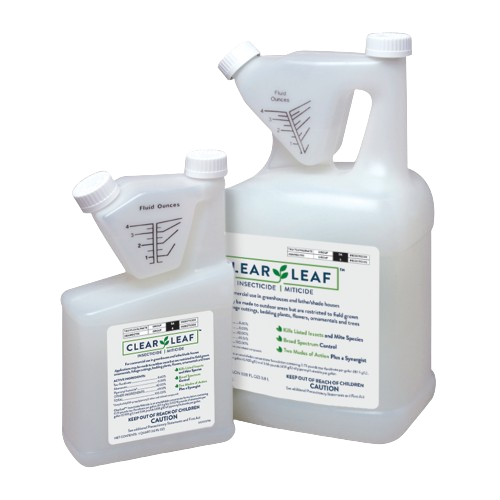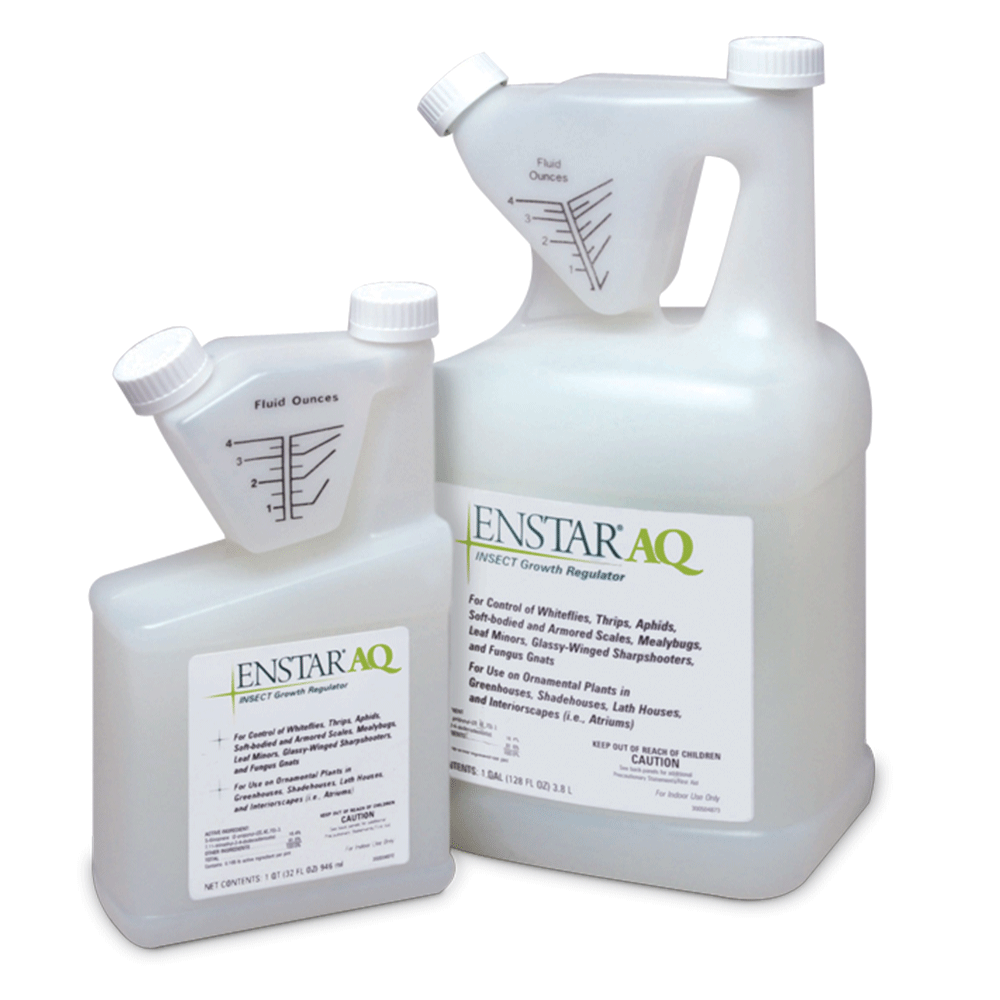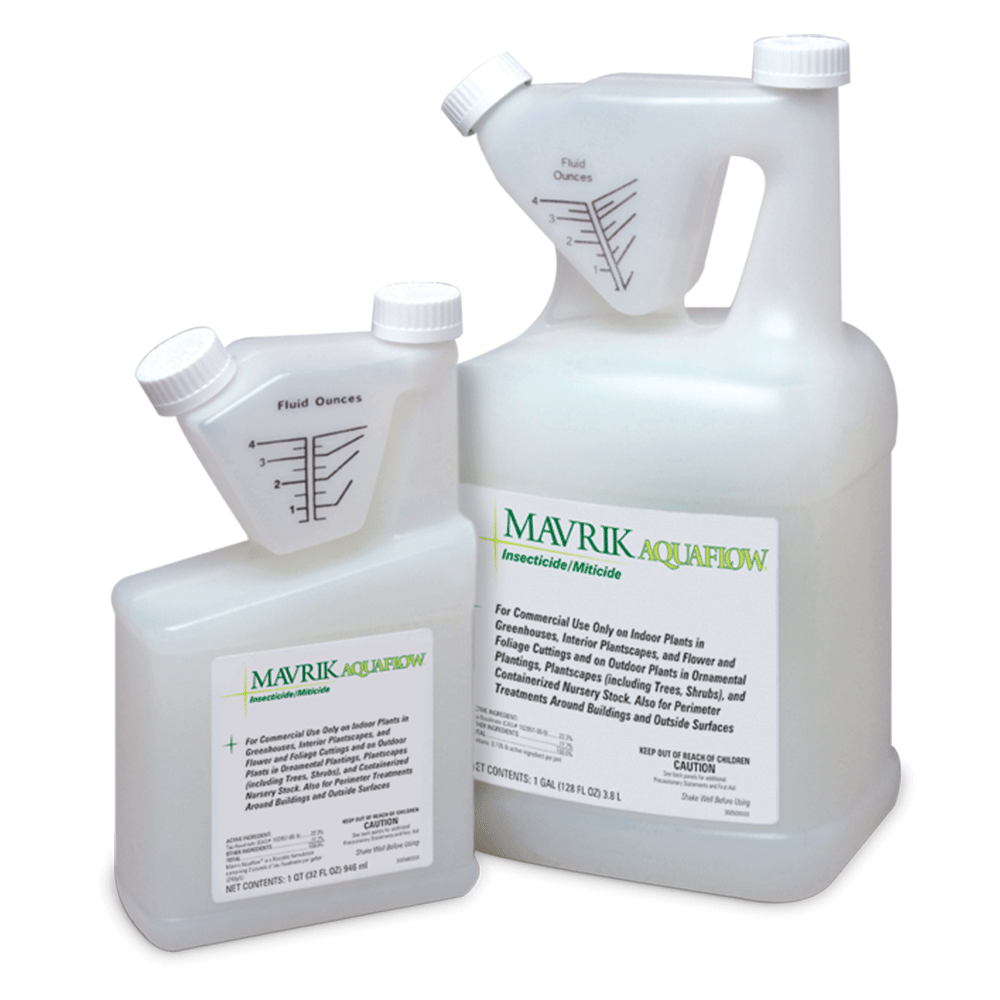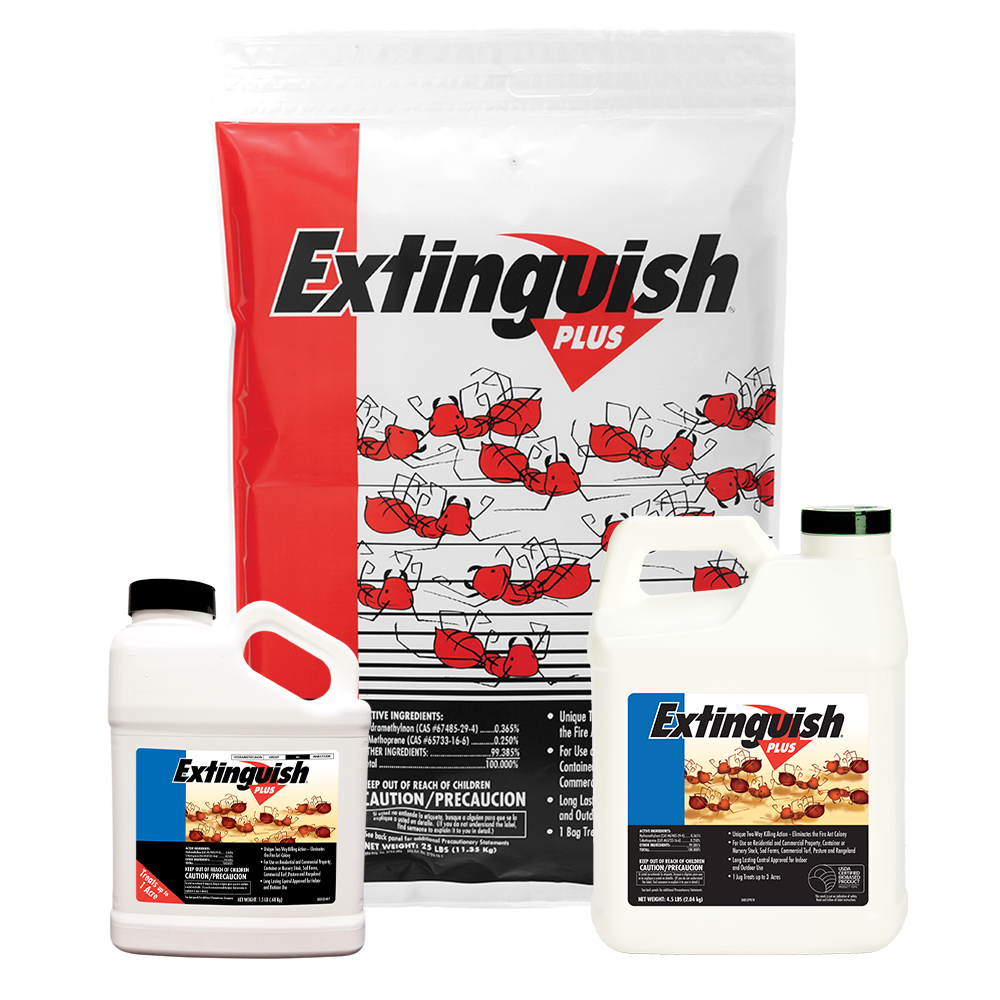Insect Identification
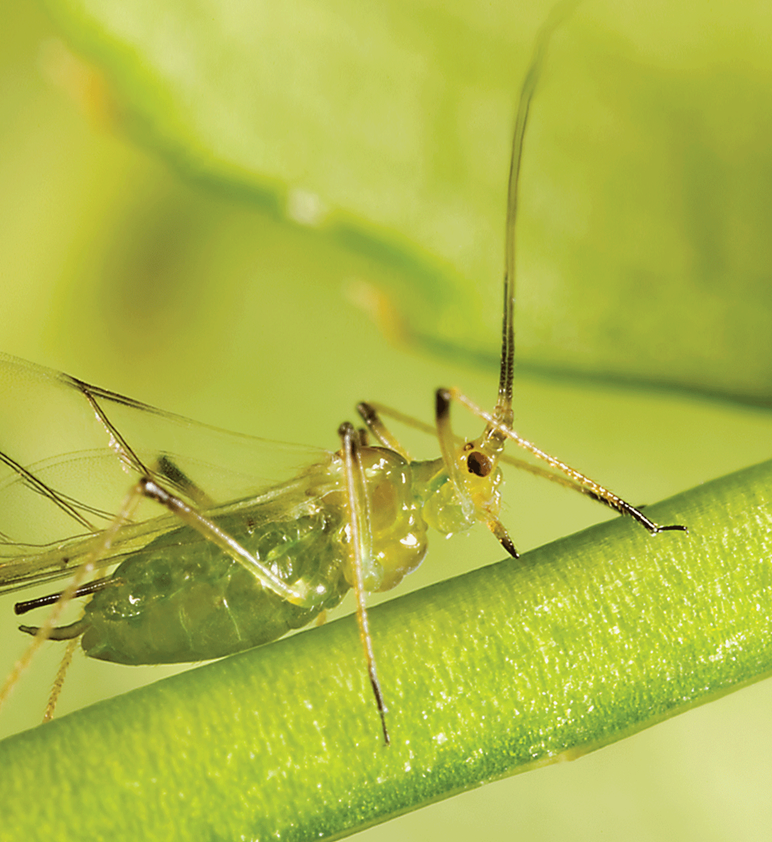
Aphids
What are aphids?
Aphids, also known as “plant lice,” are small, soft-bodied, pear-shaped insects with long antennae in the front and two short “tailpipes” in the rear.
How do I spot aphids?
Aphids are one of the first insects to arrive in the spring and come in a variety of colors, yellow, green, black, red and gray. They feed on a wide range of plants and crops, including bedding and garden plants, potted plants, cut flowers and cut greens. They also shed their skin, leaving white flecks behind on growing tips of plants or the undersides of leaves.
Why are aphids a threat?
Aphids distort flowers and foliage and stunt new plant growth. They also excrete honeydew, a sugary substance that forms a sticky coating on leaves, attracting ants. And some species of aphids do more damage by feeding directly on stems, twigs and branches.
How can I control aphids?
ClearLeaf™ and Enstar® AQ IGR can be used to control aphids and prevent populations from reaching damaging levels.
Control aphids now
Bagworms
What are bagworms?
Bagworms are one of the most damaging pests of urban trees in the northeastern and southern U.S. The insect has one generation per year, overwintering in the egg state inside the female’s pupal stage.
How do I spot bagworms?
Hatching bagworm larvae are known to disperse to surrounding plants by spinning a silken thread and traveling on the wind before finding a host plant. They then incorporate twigs, leaves and silk into new bags of their own to help them blend into the environment.
Why are bagworms a threat?
Bagworms feed on their host plant and have the potential to deal significant damage to greenhouse and nursery plants.
How can I control bagworms?
Applying ClearLeaf™ and Mavrik Aquaflow® can help control the spread of bagworms.
Control bagworms now
Chinch Bugs
What are chinch bugs?
Chinch bugs are pests of turf and pasture greens throughout the southern U.S., with scattered infestations in the western states. These tiny pests measure approximately six millimeters in length.
How do I spot chinch bugs?
Adults are black with shiny white wings. They overwinter in protected places in and around turf grass, then emerge from hibernation in spring to mate. They tend to move from lawn-to-lawn within a neighborhood and the population can cover more than 400 feet in under an hour.
Why are chinch bugs a threat?
Chinch bugs suck the sap from the grass until it withers and dies and can cause millions of dollars in turf grass damage annually.
How can I control chinch bugs?
Apply ClearLeaf™ or Mavrik Aquaflow® to help treat.
Control chinch bugs now
Fire Ants
What are fire ants?
Fire ants are distinguished from other ants by their copper brown head and body with a darker abdomen. They have three pairs of legs and a pair of antennae. Worker ants are blackish to reddish and their sizes vary from 2-to-6 millimeters.
How do I spot fire ants?
Fire ant colonies typically produce large mounds in open areas. They tend to nest in the soil, often near moist areas like river banks, pond edges, watered lawns and highway edges. However, their nests usually aren’t visible as they’ll be under objects such as timber, logs, rocks, pavers and bricks.
Why are fire ants a threat?
Fire ants often attack and can kill small animals. Unlike other ants, fire ants bite to get a grip, then sting and inject a toxic alkaloid venom. This is a painful sting for humans that feels like being burnt by fire. They also feed on young plants, seeds, and sometimes crickets.
How do I control fire ants?
Applying ClearLeaf™ or Extinguish® Plus in the spring or fall can help control the spread of fire ants.
Control fire ants now
Fungus Gnats
What are fungus gnats?
Found either on the plant or within the soil, fungus gnats fly up whenever plants are distributed.
How do I spot fungus gnats?
Measuring about an 1/8” long, adult fungus gnats are slender, dark-colored, mosquito-like flies. They have long legs, antennae and one pair of wings. Fungus gnats primarily infest in potted plants and continuously reproduce in greenhouses where warm temperatures are maintained.
Why are fungus gnats a threat?
Larvae or maggot fungus gnats cause the most damage to plants. Not only do they feed on fungi and decaying organic matter, but they also live on living plant tissue. This causes wilting, yellowing, poor growth and foliage loss. Brown scars often appear on chewed roots. Fungus gnats can severely weaken and kill plants.
How do I control fungus gnats?
Enstar® AQ controls larval stages of fungus gnats, preventing damage and reinfestation.
Control fungus gnats now
Leafhoppers
What are leafhoppers?
There are nearly 20,000 species of leafhoppers. They have piercing-sucking mouthparts and have camouflage coloration that allows them to blend into their surroundings.
How do I spot leafhoppers?
Leafhoppers have large eyes for excellent visual acuity and are expert jumpers and flyers. They have two pairs of wings and their wings expand as they go through their five nymphal instars before becoming adults.
Why are leafhoppers a threat?
Leafhoppers extract fluids out of plants and cause physical damage by inserting their mouthparts or by robbing the plant of important nutrients. More concerning is their ability to transmit infectious pathogens that spread diseases from plant to plant.
How can I control leafhoppers?
Applying ClearLeaf™ or Mavrik Aquaflow® can help control the spread of leafhoppers.
Control leafhoppers now
Mealybugs
What are mealybugs?
Mealybugs are tiny, white insects covered in waxy threads. Male mealybugs are tiny, mouthless flies that serve as sperm banks. Females are wingless and lay 300-to-600 eggs in sacks that are found on plant stems and leaves.
How do I spot mealybugs?
Mealybugs are found at the base of stems and in leaf axils. They slip into crop crevices and primarily infest in bedding, garden plants and foliage.
Why are mealybugs a threat?
Mealybugs suck the sap of plants, which results in stunted plant growth. They also excrete honeydew, a sticky substance that provides a substrate for dark-sooty mold and attracts ants.
How do I control mealybugs?
ClearLeaf™ and Enstar® AQ prevent mealybug populations from reaching damaging levels and can control root mealybugs in pots. For broad-spectrum control of adult mealybugs, use Mavrik Aquaflow®. Combine Enstar® AQ and Mavrik Aquaflow® for complete control.
Control mealybugs now
Mites
What are mites?
Mites are tiny insects that hide in small cobwebs woven underneath plant foliage or flowers.
How do I spot mites?
Mites are barely visible to the naked eye and look like small, moving dots. They come in a broad-spectrum of colors, including red, yellow, green, purple, black and translucent. Adults typically have four pairs of legs, a big differentiator from other insects.
Why are mites a threat?
Mite infestations cause leaves to turn yellow or brown and eventually fall off. They draw nutrients from plants, creating a blotchy or “salt and pepper” pattern on leaves. Mites plague numerous crops, including bedding and garden plants, potted plants, cut flowers and foliage.
How do I control mites?
ClearLeaf™ and Mavrik Aquaflow® provide broad-spectrum protection from adult mites.
Control mites now
Psyllids
What are psyllids?
Psyllids are tiny sap-sucking insects that resemble miniature cicadas. They have strong jumping legs and short antennae.
How do I spot psyllids?
Signs of a psyllid infestation include discoloration, dimpling or pock marks on leaves, leaf drop and defoliation, and the appearance of lerps. Some psyllids attack citrus, olive, potato and tomato crops. They thrive in spring when temperatures are warm and host plants are in growth mode.
Why are psyllids a threat?
Psyllids damage plants by sucking sap from the leaves. They occasionally build protective covers made from wax and honeydew, which are called lerps.
How do I control psyllids?
Applying ClearLeaf™ or Mavrik Aquaflow® can help control the spread of psyllids.
Control psyllids now
Scales
What are scales?
Scales measure from 1-to-5 millimeters long and vary dramatically in appearance, ranging from wax-covered organisms to shiny, pearl-like objects.
How do I spot scales?
Scales infest the entire gamut of greenhouse crops, including bedding and garden plants, potted flowers, cut flowers, cut greens and foliage. They can be found on leaves, branches, trunks, roots and fruits.
Why are scales a threat?
Scales remove plant sap, stunting growth and causing several types of deformities, such as chloric spots and pits. Scales also produce honeydew, a waxy secretion that can prompt the growth of dark-sooty mold on leaf surfaces, reducing photosynthesis.
How do I control scales?
Enstar® AQ Insect Growth Regulator delivers broad-spectrum control of scales.
Control scales now
Thrips
What are thrips?
Thrips are tiny, cylindrical insects with short antennae and two sets of wings. Adult thrips are brown or black.
How do I spot thrips?
Thrips infest several types of crops, including bedding and garden plants, potted plants and cut flowers. They tend to multiply faster during periods of warm, dry weather. Eggs are laid on plant tissue and inserted into small slits. They’re often hidden in protective areas of flowers or developing buds.
Why are thrips a threat?
Thrips can deal severe damage before they’re even detected. They damage plants with their scraping mouths. Thrips streak, distort and discolor flower petals and leaves, while excreting little black spots of feces that give plants a silvery, speckled appearance.
How do I control thrips?
ClearLeaf™, Mavrik Aquaflow®, and Enstar® AQ can help control an infestation of thrips.
Control thrips now
Whiteflies
What are whiteflies?
Whiteflies resemble tiny, white moths. These oval-shaped insects have two pairs of wings.
How do I spot whiteflies?
Whiteflies plague bedding and garden plants, potted plants and cut flowers. They reproduce rapidly. Infestations are localized at first before expanding to larger areas. Whitefly eggs appear cone-shaped and are located on the underside of leaves.
Why are whiteflies a threat?
Whiteflies feed on the underside of leaves with their piercing mouths, stunting plant growth. They also cause plants to become sticky and discolored.
How do I control whiteflies?
ClearLeaf™, Enstar® AQ, and Mavrik Aquaflow® can make for a winning combination in the battle against whiteflies. Enstar® AQ can prevent existing populations from reaching damaging levels, while Mavrik Aquaflow® can be applied to the underside of leaves for immediate control.
Control whiteflies nowFeatured Products
ClearLeaf™ Insecticide & Miticide
Enstar® AQ Insect Growth Regulator
Mavrik Aquaflow® Insecticide & Miticide
Extinguish® Plus
